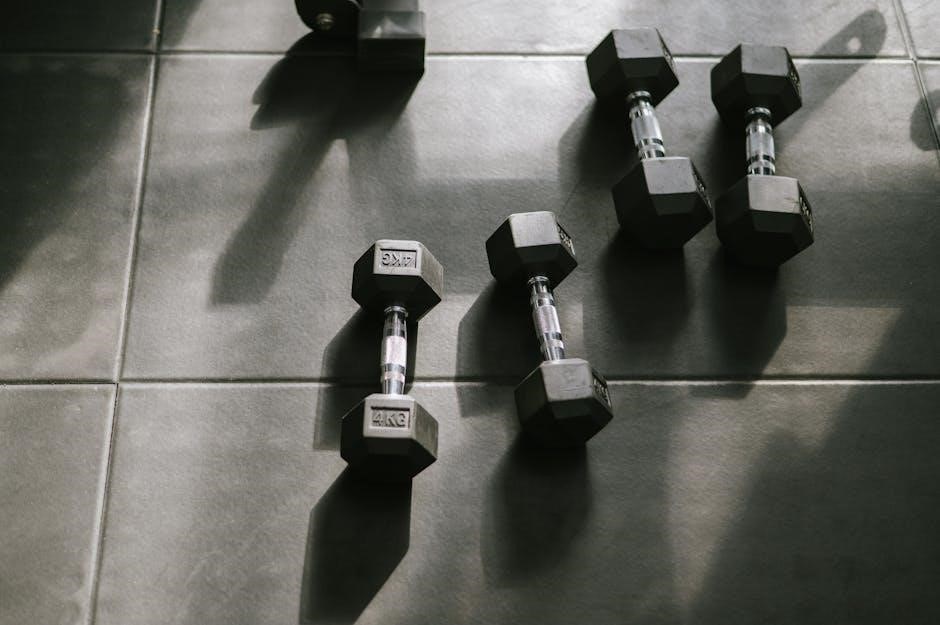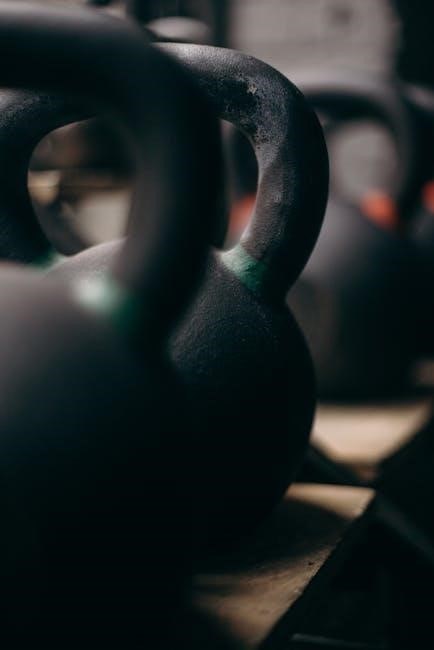A well-structured basketball strength and conditioning program enhances performance, prevents injuries, and builds resilience. It combines periodized training, functional movements, and plyometrics to optimize power and endurance for players.
Importance of Strength and Conditioning in Basketball
Strength and conditioning are crucial for basketball players to enhance performance, prevent injuries, and maintain resilience. These programs improve power, speed, and endurance, enabling players to excel in high-intensity games. A well-structured approach ensures athletes develop the physical attributes needed for quick cuts, powerful jumps, and sustained on-court performance. It also builds lean muscle and flexibility, reducing injury risks and prolonging athletic careers.
Benefits of a Well-Structured Basketball Training Program
A well-structured basketball training program offers numerous benefits, including improved strength, power, and endurance. It enhances agility, speed, and vertical jump, crucial for competitive play. Such programs also reduce injury risks through stability and mobility exercises. Additionally, they promote lean muscle growth and flexibility, ensuring players maintain peak performance throughout the season. A structured approach also fosters mental toughness and team chemistry, essential for success on the court.
Key Principles of Basketball Strength and Conditioning
Basketball strength and conditioning programs focus on periodization, functional movements, and injury prevention. They emphasize building power, endurance, and agility through structured training phases tailored to the season.
Foundational Concepts for Building Strength and Power
Building strength and power in basketball requires a focus on functional movements, progressive overload, and periodization. Emphasizing compound exercises like squats and deadlifts enhances lower body strength, while plyometrics improve explosiveness. Core stability and injury prevention are prioritized through exercises like planks and dead bugs. A well-structured program ensures athletes develop the necessary power and endurance to excel on the court, with a focus on long-term development and peak performance during the season.
Periodization in Basketball Training Programs
Periodization in basketball training involves dividing the season into specific phases to optimize performance and prevent overtraining. Preseason focuses on building strength and power, while in-season emphasizes maintenance and recovery. The offseason prioritizes maximal strength and power gains. Each phase is tailored to the athlete’s needs, ensuring peak performance during critical moments. This structured approach balances intensity and recovery, fostering long-term development and injury prevention, while aligning training with competitive demands.
Periodized Training for Basketball
Periodized training divides the season into phases, focusing on strength, power, and endurance. It ensures peak performance during critical moments while minimizing injury risks and optimizing recovery.
Preseason Strength and Conditioning Focus
The preseason phase emphasizes building foundational strength, power, and endurance. It targets key muscle groups used in basketball, such as the legs, core, and upper body. Functional movements and plyometrics are integrated to enhance explosiveness and agility. A periodized approach ensures gradual progression, allowing athletes to achieve peak physical condition before the season begins. This phase lays the groundwork for in-season performance and longevity.
In-Season Maintenance and Recovery Strategies
In-season focus shifts to maintaining strength, power, and endurance while prioritizing recovery. Players engage in modified strength workouts, emphasizing lower intensity and volume. Recovery techniques such as foam rolling, stretching, and hydration are crucial. Nutrition plays a key role in replenishing energy stores. Active rest and mobility drills are incorporated to prevent overtraining and maintain flexibility, ensuring players remain competitive throughout the season.
Offseason Training for Maximum Gains
The offseason is crucial for building foundational strength, power, and conditioning. A periodized approach focuses on hypertrophy, strength, and power phases. Emphasis is on muscle gain, explosiveness, and endurance. Mobility and flexibility exercises enhance movement efficiency. This structured training ensures peak condition by the season’s start.

Injury Prevention and Management
Injury prevention focuses on strengthening key muscle groups, improving mobility, and enhancing stability. Proper conditioning and core exercises reduce the risk of common basketball injuries, ensuring longevity.
Common Injuries in Basketball and Their Prevention
Basketball players often suffer from knee injuries, ankle sprains, and shoulder strains due to explosive movements and sudden changes in direction. Strengthening exercises, proper warm-ups, and balance training can significantly reduce injury risks. Incorporating plyometrics and stability drills into conditioning programs helps build resilience, ensuring players stay healthy and perform at their best throughout the season.
Exercises for Enhancing Mobility and Stability
Exercises like goblet squats, leg curls, and calf raises improve mobility and stability, essential for basketball. These movements strengthen key muscle groups, enhancing flexibility and balance. Incorporating hip adductions and cable rows further stabilizes the core and joints, reducing injury risk and improving overall court performance.
Core and Functional Training
Core and functional training are vital for basketball, focusing on exercises like planks, dead bugs, and medicine ball woodchoppers to enhance stability, balance, and overall athletic performance.
Core Exercises for Basketball Performance
Effective core exercises, such as planks, dead bugs, and medicine ball woodchoppers, enhance stability, balance, and rotational power. These movements improve posture, reduce injury risk, and boost overall court performance, making them essential for basketball athletes; Regular core training also strengthens the muscles used in explosive movements like jumps and quick direction changes, ensuring players maintain peak physical condition throughout the season.
Functional Movements for Court-Specific Skills
Functional movements like step-ups, lateral bounds, and medicine ball drills mimic basketball actions, enhancing agility, stability, and court-specific skills. These exercises improve explosive drives, sharp cuts, and quick changes of direction. By targeting movements like pivoting and shuffling, players develop the ability to maintain balance and generate power during game-like scenarios, ensuring optimal performance on the court.
Plyometrics and Explosive Power
Plyometric exercises like box jumps and burpees enhance explosive power, crucial for basketball. These movements improve vertical jump and speed, helping players dominate on the court.
Lower Body Plyometric Exercises
Lower body plyometrics, such as box jumps, depth jumps, and burpees, are essential for basketball. These exercises enhance explosiveness, vertical jump, and speed, crucial for dunking and quick accelerations. By focusing on powerful, dynamic movements, players improve their ability to explode off the court, enabling dominance in rebounding and fast breaks. Incorporating these drills mimics game-specific actions, ensuring functional strength and agility for peak performance.
Upper Body Plyometric Training
Upper body plyometric exercises, such as medicine ball throws and plyo push-ups, enhance explosive power and endurance. These drills target the chest, shoulders, and triceps, improving rebounding and defensive capabilities. By incorporating dynamic movements, players develop the strength and speed needed for powerful blocks and quick reactions. This training is crucial for maintaining dominance on the court and executing high-intensity plays effectively during games.
Conditioning Circuits for Basketball
Conditioning circuits are designed to enhance endurance, agility, and speed. They combine sprint drills, ladder exercises, and court-specific movements to improve cardiovascular fitness and muscular endurance for basketball performance.
Designing Effective Conditioning Circuits
Effective conditioning circuits for basketball combine intensity, variety, and periodization. They should include sprint drills, ladder exercises, and court-specific movements to improve speed, agility, and endurance. Circuits can be individual, partner, or group-based, with stations focusing on similar or mixed exercises. Progression is key, with increasing intensity and complexity as the season advances. Ensure circuits align with the training phase, whether preseason, in-season, or offseason, to maximize performance and prevent overtraining.
Examples of Court Running and Agility Drills
Court running and agility drills are essential for improving speed and quick changes of direction. Examples include figure-eight dribbles, cone drills, and zigzag sprints. These exercises mimic game situations, enhancing reaction time and acceleration. Incorporate ladder drills for foot speed and shuttle runs to build explosive power. These drills are versatile and can be modified to suit different skill levels, ensuring players stay agile and competitive during the season.
Nutrition and Recovery Strategies
Nutrition fuels performance, with balanced diets rich in protein, carbs, and hydration. Recovery strategies like stretching, foam rolling, and sleep optimize muscle repair and energy replenishment for athletes.
Nutritional Guidelines for Basketball Athletes
A balanced diet is crucial for basketball performance. Athletes should focus on lean proteins, complex carbs, and healthy fats to fuel energy needs. Proper hydration is essential for endurance and recovery. Timing meals around practices and games ensures optimal energy levels. Avoiding junk food and excessive sugar helps maintain peak performance. A well-planned nutrition strategy supports muscle repair, strength, and agility, enabling athletes to perform at their best on the court.
Recovery Techniques for Optimal Performance
Effective recovery is vital for basketball athletes to maintain peak performance. Techniques include stretching, foam rolling, and ice baths to reduce muscle soreness. Prioritizing sleep and hydration aids in muscle repair and energy replenishment. Incorporating periodized training and post-workout recovery routines ensures athletes can sustain intense activity levels throughout the season. Proper recovery strategies help prevent overtraining and injuries, enabling consistent and optimal performance on the court.
Program Design and Implementation
A well-structured basketball strength and conditioning program requires careful planning, periodization, and monitoring. It should align with team goals, ensuring progressive overload and adaptability for optimal results.
Creating a Comprehensive Training Schedule
A well-structured training schedule ensures balance and progression. It should include strength, plyometrics, agility, and conditioning exercises, tailored to the season phase. Periodization is key, with specific focuses during preseason, in-season, and offseason. Each session should have clear goals, such as building strength or enhancing endurance, while allowing for recovery and adaptation. A comprehensive schedule also integrates skill work and team practices.
Monitoring Progress and Adjusting the Program
Regularly monitoring an athlete’s progress is crucial for optimal results. This involves tracking strength gains, vertical jump improvements, and endurance levels; Coaches should use data from performance tests and feedback to adjust the program. Adjustments may include increasing intensity, modifying exercises, or changing the training focus. Continuous assessment ensures the program remains effective and aligned with the athlete’s goals and seasonal demands.
Case Studies and Success Stories
Professional teams like the Orlando Magic have seen significant improvements in player performance through structured strength programs. These programs often highlight enhanced vertical jumps and overall strength gains.
Real-World Examples of Effective Programs
Basketball England’s 8-week program focuses on maintaining conditioning, enhancing coordination, and building muscular strength. Weber State University’s periodized approach ensures athletes peak during critical moments. The Orlando Magic’s strength program improved vertical jumps and overall performance. These real-world examples demonstrate how structured training enhances player resilience, agility, and power, providing practical insights for coaches and players seeking proven strategies for success on the court.
Success Stories from Professional Teams
The Orlando Magic’s strength program improved vertical jumps and overall performance. NBA teams use periodized training to ensure peak performance during critical moments. These success stories highlight how professional teams leverage structured strength and conditioning programs to enhance player resilience, agility, and power, providing practical insights for coaches and players seeking proven strategies for success on the court, as seen in their improved performance metrics and injury prevention.

Tools and Resources for Coaches
Coaches can access free PDF downloads, including comprehensive basketball strength programs and conditioning guides, to design effective workouts and track player progress efficiently.
Recommended Equipment for Strength Training
Essential equipment includes barbells, dumbbells, resistance bands, and medicine balls for building strength and power. A pull-up bar and exercise balls are ideal for core and stability work. Incorporate plyometric boxes for explosive jumps and kettlebells for functional movements. These tools help athletes improve muscle endurance, agility, and overall basketball performance, ensuring a well-rounded strength training program tailored to court demands.
Free PDF Downloads for Basketball Programs
Free PDF downloads for basketball programs offer comprehensive guides for strength and conditioning. These resources include core exercises, plyometric training, and periodized plans tailored to preseason, in-season, and offseason needs. Available on platforms like MuscleAndStrength.com and Shop.StrongerTeam.com, they provide structured workouts to enhance performance and prevent injuries, making them invaluable for players and coaches seeking effective training strategies.

Sustainability and Long-Term Development
Sustainable basketball strength and conditioning programs focus on building a long-term training plan, ensuring progressive overload and maintaining player engagement through varied and challenging exercises.
Building a Long-Term Training Plan
A long-term training plan for basketball focuses on progressive overload, periodization, and injury prevention. It incorporates annual, seasonal, and weekly cycles, ensuring continuous improvement; The plan emphasizes foundational strength, power, and endurance, adapting to the player’s developmental stage. By integrating specific exercises and drills, it ensures sustained growth and peak performance during critical periods. Consistency and adaptability are key to achieving long-term success and resilience.
Maintaining Player Engagement and Motivation
Maintaining engagement and motivation requires a structured yet dynamic approach. Setting clear, achievable goals and incorporating varied, challenging exercises helps keep players focused. Regular feedback, team chemistry, and celebrating progress foster a positive environment. Periodized training ensures novelty and prevents monotony, while aligning workouts with seasonal objectives keeps athletes motivated. Recognizing individual and team achievements reinforces commitment to the program and long-term success.
A well-structured basketball strength and conditioning program is essential for enhancing performance, preventing injuries, and achieving peak athleticism. Consistent effort and adherence to the program yield optimal results.
Final Thoughts on Effective Basketball Strength and Conditioning
A well-designed basketball strength and conditioning program is crucial for maximizing performance, preventing injuries, and achieving long-term success. Periodized training, proper nutrition, and recovery strategies are essential. Incorporating functional movements, plyometrics, and core exercises ensures players develop the necessary strength, power, and agility. Consistent effort and adherence to the program, along with a focus on mobility and stability, will help athletes reach their full potential and excel on the court.
Encouragement for Continuous Improvement
Continuous improvement in basketball strength and conditioning requires dedication and a growth mindset. Players should regularly assess their progress and adjust their training programs to address weaknesses. Seeking guidance from experienced coaches and incorporating new techniques can foster development. Embracing challenges and staying committed to the process ensures sustained growth and peak performance on the court. Every effort contributes to achieving long-term goals and success in basketball.

Additional Resources
Explore recommended reading, guides, and online communities for basketball strength and conditioning. Access free PDF downloads and expert forums to enhance your training knowledge and strategies.
Recommended Reading and Further Learning
Discover comprehensive guides, research papers, and expert-authored books on basketball strength and conditioning. Explore resources like the Journal of Strength and Conditioning Research, Basketball England’s training manuals, and downloadable PDFs from reputable sites like Muscle & Strength. These materials offer in-depth insights into periodized training, injury prevention, and functional exercises to enhance performance and inform your program design.
Online Communities for Strength Coaches
Engage with online forums like Reddit’s r/strengthtraining and r/basketball, where coaches share insights and resources. Join Facebook groups dedicated to basketball strength and conditioning for practical advice. Professional networks like the NSCA and CSCS forums offer evidence-based discussions. Twitter communities, such as #StrengthTraining and #BasketballSC, connect coaches globally. Explore platforms like StrengthCoach.com for detailed training plans and BasketballHQ.com for video tutorials and expert Q&As.
Call to Action
Start your basketball strength and conditioning journey today! Transform into a stronger, faster, and more resilient player with our expert-designed program. Elevate your game now and achieve peak performance.
Start Your Basketball Strength and Conditioning Journey Today
Embark on a transformative journey with our basketball strength and conditioning program; Designed to enhance power, speed, and agility, this program includes periodized training, functional exercises, and recovery strategies. Whether you’re a beginner or an elite athlete, our structured approach ensures you achieve peak performance and stay injury-free. Download our comprehensive guide now and elevate your game to new heights!
